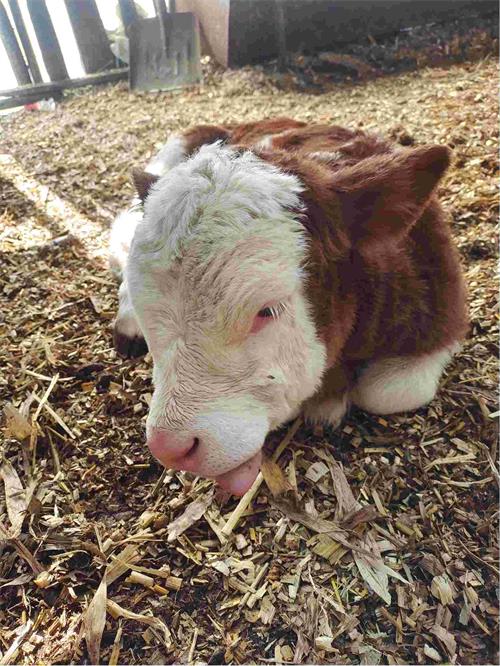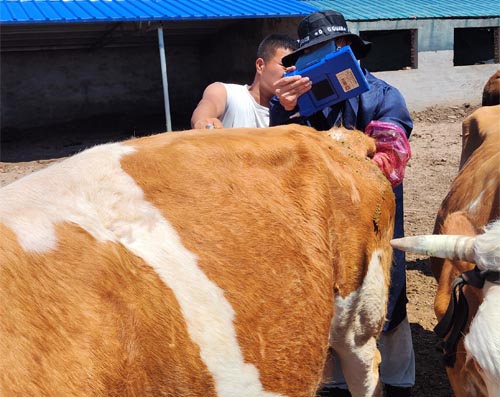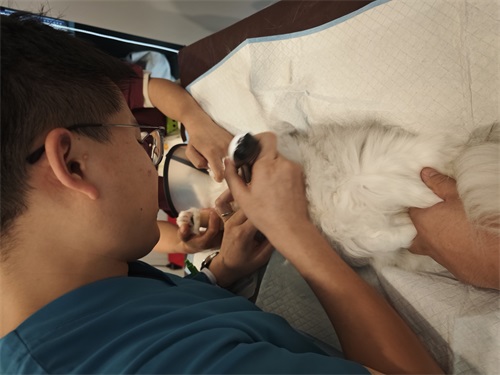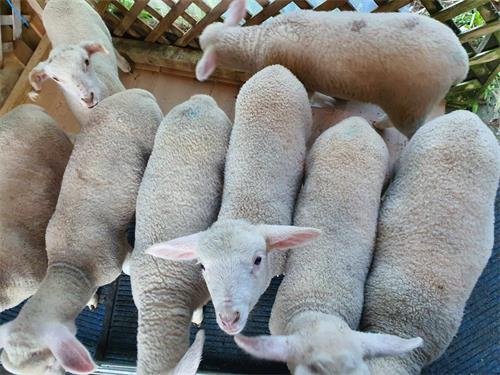In modern dairy farming, maximizing reproductive efficiency is a top priority. Postpartum uterine health plays a pivotal role in achieving high conception rates, minimizing open days, and ensuring sustainable milk production. One often overlooked factor influencing uterine recovery is the birth weight of the calf. Recent field applications of veterinary ultrasonography have shown that the weight of the newborn calf may significantly affect how quickly a cow’s uterus recovers after calving.

As an increasingly common and non-invasive diagnostic method, Veterinary ultrasound has become an indispensable tool on many dairy farms across the globe. From North America to Europe, producers and veterinarians alike are using it not only for pregnancy detection, but also for evaluating uterine involution and identifying common postpartum complications such as metritis and endometritis. In this article, we explore the relationship between calf birth weight and uterine recovery, and how ultrasonography enables us to manage this dynamic more effectively.
Calf Birth Weight and Uterine Recovery: The Scientific Connection
Research and field data indicate that the ideal calf birth weight that supports faster uterine recovery is within the range of 40–45 kg. Cows giving birth to calves in this weight range tend to have the shortest uterine involution period and the fewest open days. This correlation is consistent with reports from international veterinary literature, where moderate-sized calves are linked with less physical trauma during calving, fewer metabolic disturbances, and lower risks of uterine infection.
Conversely, when calf birth weights fall below 40 kg, the recovery period tends to be longer. Although smaller calves may pose a lower risk of dystocia (difficult birth), they may be underdeveloped, leading to complications related to incomplete placental maturity. This can hinder natural placental separation, resulting in retained placenta and delayed uterine involution. In these cases, ultrasonography is crucial in identifying persistent uterine fluid or retained tissues that are not easily detectable through palpation alone.
On the other end of the spectrum, calves weighing more than 45 kg are more likely to cause dystocia. Assisted calving increases the chance of introducing pathogens into the uterus, particularly if hygienic practices are suboptimal. Prolonged or forceful deliveries also lead to physical trauma and inflammation of the uterine lining. Such trauma may result in metritis or subclinical endometritis—both of which significantly delay uterine recovery and reduce conception rates. In global herd management practice, this emphasizes the importance of controlling calf size through careful sire selection, appropriate dry-period nutrition, and frequent monitoring using ultrasound.
Using Veterinary Ultrasound to Track Uterine Involution
Uterine involution refers to the process by which the uterus returns to its pre-pregnant size and function. This involves the reduction of uterine size, elimination of fluid and tissue remnants, and restoration of a normal endometrial surface. Veterinary ultrasound plays a central role in tracking this recovery process, providing real-time images of uterine diameter, wall thickness, and contents.

B-mode ultrasonography (gray-scale imaging) is most commonly used to assess the uterus post-calving. With skilled scanning, the practitioner can measure the uterine horn diameters and compare them over time. In cows with optimal involution, both horns return to a symmetrical, non-fluid-filled state within 25–30 days postpartum. Deviations from this pattern are early indicators of complications.
For instance, cows with retained fetal membranes or delayed placental separation—conditions more common in underweight or overweight calf deliveries—often show echogenic intrauterine fluid, thickened endometrium, or asymmetrical horns for a prolonged period. Detecting such conditions early enables timely interventions with uterine therapies, antibiotics, or anti-inflammatory drugs, minimizing reproductive setbacks.
Impact on Open Days and Rebreeding
In international dairy operations, reproductive performance is often measured in terms of "days open"—the interval between calving and successful conception. A prolonged open period negatively affects profitability by delaying the cow's next lactation cycle and increasing maintenance costs. Studies conducted in the U.S., Netherlands, and New Zealand consistently demonstrate that cows suffering from delayed uterine involution take an additional 29–50 days to conceive compared to healthy cows.
Ultrasound-based monitoring has proven effective in reducing days open. By identifying cows with poor uterine recovery early, farmers can delay insemination and provide therapeutic treatments, rather than wasting breeding attempts on cows unlikely to conceive. This data-driven approach enhances conception success per insemination and reduces overall breeding costs.
Understanding and Diagnosing Endometritis
Endometritis is a common postpartum uterine disease, particularly in herds with poor calving hygiene, high rates of dystocia, or frequent metabolic disorders like ketosis and hypocalcemia. It is typically classified as either acute or chronic, depending on the duration and severity of inflammation.
With ultrasound, endometritis can be diagnosed even when clinical signs are absent. The presence of intrauterine fluid, irregular endometrial structure, or gas bubbles within the uterine lumen on the ultrasound image are indicative of infection. This subclinical form of endometritis is particularly insidious, as affected cows may appear healthy but fail to conceive for multiple cycles.
International protocols for endometritis management—such as those recommended by the European Food Safety Authority and the American Association of Bovine Practitioners—strongly emphasize routine postpartum ultrasound scanning for early detection. The treatment is most successful when implemented before the cow enters the voluntary waiting period for first breeding (typically 45–60 days postpartum).
Complications and Long-Term Impact
If endometritis or poor uterine recovery is not addressed early, the condition may evolve into more serious reproductive diseases, including:
Uterine pyometra (pus accumulation)
Hydrometra (watery fluid accumulation)
Adhesions to adjacent organs
Salpingitis (inflammation of the oviduct)
These complications severely impair fertility, often leading to culling. Additionally, cows with ongoing uterine infections are more susceptible to mastitis, compounding the economic losses. In developed dairy sectors such as Canada and Denmark, uterine health is now closely tied to overall cow longevity, with specific herd management software tracking recovery patterns via regular ultrasound updates.
Best Practices to Reduce Risk Based on Calf Weight
To reduce the negative impacts of calf birth weight on uterine recovery, progressive dairy farms are implementing a combination of genetic and management strategies, such as:
Selecting sires with low or moderate calving difficulty scores for heifers
Monitoring nutrition in the dry period to avoid over-conditioning
Closely observing calving progress to limit unnecessary interventions
Applying strict hygienic protocols during assisted births
Conducting routine ultrasound checks within 2–3 weeks postpartum
These strategies are increasingly supported by automated data collection systems integrated with herd management software that track birth weight, calving assistance, and recovery metrics.
Conclusion
Veterinary ultrasonography has opened a new frontier in reproductive monitoring in dairy cows. It allows producers and veterinarians to visualize and measure the subtle effects of calf birth weight on postpartum uterine health. As the data shows, calves born in the optimal 40–45 kg range correlate with the shortest uterine recovery times and fewest open days. Both lighter and heavier calves introduce specific risks—ranging from delayed placental separation to dystocia and infection.
By leveraging ultrasound diagnostics, farmers can detect problems early, initiate targeted treatments, and avoid breeding delays. Ultimately, this leads to improved herd fertility, lower culling rates, and increased profitability. Across the globe, from small family farms to industrial-scale dairies, incorporating ultrasound into postpartum cow care is quickly becoming a best practice—and understanding calf birth weight is a critical part of the equation.
link: https://www.bxlimage.com/nw/1209.html
tags:








